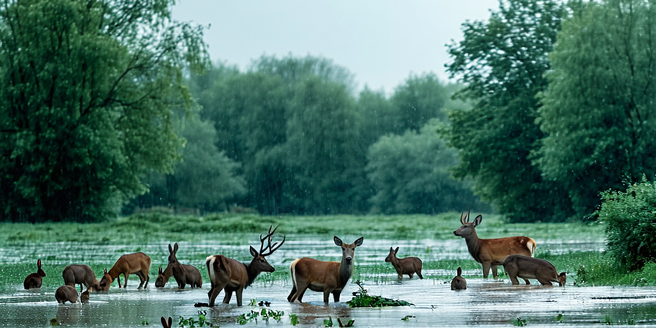
Understanding the Impact of Floods on Wildlife
Floods significantly alter wildlife habitats, often resulting in the displacement of animals and the destruction of food sources. Many creatures, unable to cope with the sudden environmental changes, face survival challenges. Aquatic species may temporarily benefit from expanded water bodies, but land animals often find themselves stranded. Separated from their groups, they risk predation and starvation. Vegetation loss during floods removes critical shelters and food, leading to biodiversity loss. Migratory patterns are disrupted, affecting mating and feeding behaviors. Communities living near affected areas can inadvertently become obstacles to wildlife recovery. Conservation efforts must address both immediate rescue operations and long-term habitat restoration. Understanding these impacts is crucial for creating strategic conservation plans.
Identifying At-Risk Animal Habitats
Knowing which habitats are vulnerable to flooding is crucial in preparing adequate protection strategies for wildlife. Endangered areas often include low-lying wetlands, riverbanks, and coastal regions, which are naturally prone to water overflow. These regions, home to diverse flora and fauna, face the greatest risks during flooding. Urban expansion and deforestation exacerbate the situation by weakening the land’s ability to absorb excess water. Early identification and monitoring of these sensitive ecosystems can aid in developing proactive measures. Assessments should consider both the frequency and intensity of potential flooding events. Implementing buffer zones and constructing barriers may help mitigate the damage. Community involvement and support are vital in preserving these habitats, ensuring that at-risk areas are prioritized in conservation efforts.
Strategies for Protecting Endangered Species
Effectively protecting endangered species during floods involves a multi-faceted approach. Firstly, creating corridors that allow safe passage to higher ground is essential. These escape routes should be regularly maintained and clear of obstacles. Additionally, establishing protected zones that remain accessible during floods can serve as refuges for vulnerable species. Collaboration with local communities to monitor endangered populations can provide crucial data to anticipate movements and behavioral changes. It is also critical to implement educational programs that emphasize the importance of preserving local ecosystems to maintain biodiversity. Equipping rangers and wildlife officers with the necessary tools and training enables rapid response. Engaging in habitat restoration projects post-flooding ensures long-term survival and recovery for endangered species. Conservation plans must adapt to incorporate both current and future environmental challenges.
Emergency Wildlife Rescue Techniques
In flood situations, prompt and effective wildlife rescue techniques are vital to saving stranded animals. The first step is rapid assessment of affected areas to prioritize rescue operations. Volunteers and rescue teams should be trained in safely handling diverse species under stress. Use of specialized equipment like nets, carriers, and boats can enhance rescue efficiency. It is essential to coordinate with local authorities to gain access to restricted areas quickly. Establishing temporary shelters with medical facilities allows for immediate care and rehabilitation of rescued animals. Effective communication strategies can recruit volunteers and donations swiftly. Proper record-keeping is crucial to track rescued animals and monitor their rehabilitation process. Conducting drills and simulations regularly can prepare teams for real-life scenarios.
Collaborating with Conservation Organizations
Collaboration with conservation organizations is fundamental in enhancing wildlife protection during floods. These partnerships foster resource sharing, ensuring that funds, equipment, and expertise are optimally utilized. By working together, teams can streamline communication channels and unify efforts across regions, creating a more efficient response system. Conservation organizations often have established networks and protocols that aid in rapid data collection and dissemination. Joint training programs can enhance on-ground capabilities, ensuring that both volunteers and professionals are well-equipped for emergency response. Public awareness campaigns led by these organizations can mobilize community support quickly, drawing attention to urgent needs during a crisis. Collaborative efforts optimize the impact and reach of conservation initiatives, paving the way for innovative solutions and long-term sustainability.
Ensuring Long-term Wildlife Rehabilitation
Long-term wildlife rehabilitation post-floods necessitates careful planning and ongoing support. The process begins with thorough health assessments to address injuries and illnesses in rescued animals. Nutritional support, tailored to species-specific needs, is crucial for recovery. Habitats must be gradually restored to encourage natural behaviors and self-sufficiency in released animals. Monitoring programs should be established to track the progress of rehabilitated wildlife, providing data to adapt strategies as needed. Public education initiatives play a pivotal role in fostering understanding and support for rehabilitation efforts. Partnering with local communities can facilitate the re-establishment of habitats and ensure ongoing protection. Securing sustainable funding and resources aids in maintaining these programs. The overarching goal of rehabilitation is to restore balance, allowing wildlife to thrive in their natural environments.
